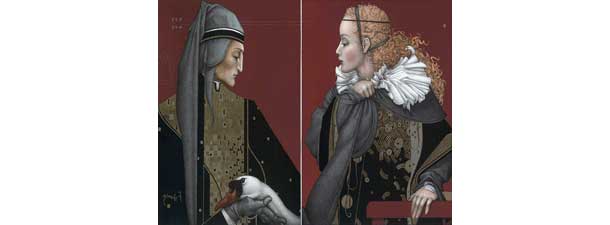
Leviathan 2
December 1, 2011
Mission statement by the editors
December 1, 2011“Arbitrium tu, dea, floris
habe”… Saepe ego digestos volui
numerare colores, nec potui:
numero copia maior erat.
Ovidio Fasti. V 210
“Goddess take charge of the flowers.” Often I
wanted to count the colours but I couldn’t because the
profusion was beyond counting.
Ovidio Fasti. V 210

Allegory of Spring by Botticelli
N
No painting better depicts springtime than Sandro Botticelli’s Primavera, also called Allegory of Spring, painted in 1482.
The painting, counterintuitively, should be viewed from right to left. It portrays Zephirus, the biting wind of March, who kidnaps and possesses the nymph Chloris. He later marries her and transforms her into the goddess of spring, eternal bearer of life, scattering roses on the ground. Venus presides over the garden – an orange grove – accompanied by the Graces, at whom Cupid takes aim. They bear jewels in the colours of the Medici family, while the figure of Mercury (sometimes interpreted to be Mars) holds aloft his caduceus to keep the garden safe from threatening clouds.
The painting’s origins are unclear; some historians claim it was commissioned by Lorenzo de Medici or by Lorenzo di Pierfrancesco de Medici, at a later date. The painting is for the most part inspired by a poem of Ovid’s that describes the arrival of spring. Whatever the truth of its origins and inspiration, it was in the collection of Lorenzo di Pierfrancesco de Medici from 1499, and since 1919 it has hung in the Uffizi Gallery in Florence.
Despite the many different meanings attributed to Botticelli’s painting overall, the flowers in the picture certainly represent love and joy. He includes about five hundred varieties, of which 240 are not flowering and 60-70 are only cereal grasses or sedges. About 138 of the 190 flowering plants have been roughly identified, while 38 varieties remain dubious, and 19 unrecognisable.
Cypress and yew trees form the background to the garden while a crown of myrtle creates a halo around Venus’s head. There are citrus trees full of both flowers and fruit with leaves reminiscent of wild trees but without the thorns. Botticelli also depicts the fruit from the garden of the Hesperides, the bitter oranges sacred to Venus that recall the sorrow of love, epitomised by the marriage between Juno and Jupiter. He also includes the fruit associated with the Medici family in their coat of arms. As the plant Venus has chosen to adorn herself with as she is born out of the sea, the myrtle symbolises the love and desire that are so inextricably linked with this goddess.
In this feast of flowers, we wanted to come up with our own celebration of spring by taking a look at poems written from different ages and in different languages, just to provide another sound picture as to how people around the world have reacted to this feeling of renewal in nature that we call spring. Let’s hope that these verses, in whatever language you choose, can do for you what Ovid’s poem once did for Botticelli.
De colores
[two_column]
Spanish version
De colores, de colores
Se visten los campos en la primavera.
De colores, de colores
Son los pajaritos que vienen de afuera.
De colores, de colores
Es el arco iris que vemos lucir.
Y por eso los grandes amores
De muchos colores me gustan a mí.
Y por eso los grandes amores
De muchos colores me gustan a mí.
De colores, de colores
Brillantes y finos se viste la aurora.
De colores, de colores
Son los mil reflejos que el sol atesora.
De colores, de colores
Se viste el diamante que vemos lucir.
Y por eso los grandes amores
De muchos colores me gustan a mí.
Y por eso los grandes amores
De muchos colores me gustan a mí.
Canta el gallo, canta el gallo
Con el quiri, quiri, quiri, quiri, quiri.
La gallina, la gallina
Con el cara, cara, cara, cara, cara.
Los pollitos, los pollitos
Con el pío, pío, pío, pío, pí.
Y por eso los grandes amores
De muchos colores me gustan a mí.
Y por eso los grandes amores
De muchos colores me gustan a mí.
Jubilosos, jubilosos
Vivamos en gracia puesto que se puede.
Saciaremos, saciaremos
La sed ardorosa del Rey que no muere.
Jubilosos, jubilosos
Llevemos a Cristo un alma y mil más.
Difundiendo la luz que ilumina
La gracia divina del gran ideal.
Difundiendo la luz que ilumina
La gracia divina del gran ideal.
[/two_column]
[two_column_last]
English version
In colours, in colours
The fields are dressed in the spring.
In colours, in colours
Are the little birds that come from outside.
In colours, in colours
Is the rainbow that we see shining.
And that is why I love
The great loves of many colours
And that is why I love
The great loves of many colours.
In colours, in colours
Brilliant and delicate is dressed the dawn.
In colours, in colours
Are the thousand gleams the sun treasures.
In colours, in colours
Is dressed the diamond we see shining.
And that is why I love
The great loves of many colours.
And that is why I love
The great loves of many colours.
The rooster sings, the rooster sings
With a cock-a-doodle, cock-a-doodle-doo.
The hen, the hen
With a cluck, cluck, cluck, cluck, cluck.
The chicks, the chicks
With a cheep, cheep, cheep, cheep, cheep.
And that is why I love
The great loves of many colours.
And that is why I love
The great loves of many colours.
Joyous, joyous
Let us live in grace since we can.
Let us quench, let us quench
The burning thirst of the King who does not die.
Joyous, joyous
Let us bring to Christ a soul and thousand more.
Spreading the light that illuminates
The divine grace from the great ideal.
Spreading the light that illuminates
The divine grace from the great ideal.
[/two_column_last]
Le Muguet
by Maurice Careme
Translated by Philip Rham
[two_column]
French version
Cloches naïves du muguet,
Carillonnez ! car voici Mai !
Sous une averse de lumière,
Les arbres chantent au verger,
Et les graines du potager
Sortent en riant de la terre.
Carillonnez! car voici Mai!
Cloches naïves du muguet!
Les yeux brillants, l’âme légère,
Les fillettes s’en vont au bois
Rejoindre les fées qui, déjà,
Dansent en rond sur la bruyère.
Carillonnez ! car voici Mai !
Cloches naïves du muguet !
[/two_column]
[two_column_last]
English version
O you innocent lily of the valley bells
Ring out! For May is here!
In a shower of light
The trees in the orchard sing out
And the seeds burst merrily
Up out of the earth
Ring out! For May is here!
O you innocent lily of the valley bells
Bright-eyed. spirits light
The little girls run to the woods
To join the fairies, already
Dancing round in the heather
Ring out! For May is here!
O you innocent lily of the valley bells
[/two_column_last]
Sumer is Icumen In – Summer Has Arrived
[two_column]
Middle English
Sumer is icumen in,
Lhude sing cuccu!
Groweth sed and bloweth med
And springth the wde nu,
Sing cuccu!
Awe bleteth after lomb,
Lhouth after calue cu.
Bulluc sterteth, bucke uerteth,
Murie sing cuccu!
Cuccu, cuccu, wel singes thu cuccu;
Ne swik thu nauer nu.
Chorus:
Sing cuccu nu. Sing cuccu.
Sing cuccu. Sing cuccu nu!
[/two_column]
[two_column_last]
Modern English
Summer has arrived,
Loudly sing, Cuckoo!
The seed grows and the meadow
blooms
And the wood it springs anew,
Sing, Cuckoo!
The ewe bleats after lamb
The cow lows after calf.
The bullock stamps, the stag farts,
Merrily sing, Cuckoo!
Cuckoo, cuckoo, well you sing,
cuckoo;
Don’t ever you stop now,
Sing cuckoo now. Sing, Cuckoo.
Sing Cuckoo. Sing cuckoo now!
[/two_column_last]
Che dice la pioggerellina di marzo?
by Angiolo Silvio Novaro
translated. Philip Rham
[two_column]
Italian version
Che dice la pioggerellina
Di marzo, che picchia argentina
Sui tegoli vecchi
Del tetto, sui bruscoli secchi
Dell’orto, sul fico e sul moro
Ornati di gèmmule d’oro?
Passata è l’uggiosa invernata,
Passata, passata!
Di fuor dalla nuvola nera,
Di fuor dalla nuvola bigia
Che in cielo si pigia,
Domani uscira’ Primavera
Guernita di gemme e di gale,
Di lucido sole,
Di fresche viole,
Di primule rosse, di battiti d’ale,
Di nidi,
Di gridi,
Di rondini ed anche
Di stelle di mandorlo, bianche……
Che dice la pioggerellina
di marzo, che picchia argentina
sui tegoli vecchi
del tetto, sui bruscoli secchi
dell’orto, sul fico e sul moro
Ornati di gèmmule d’oro?
Ciò canta, ciò dice:
E il cuor che l’ascolta è felice.
[/two_column]
[two_column_last]
English version
What is it telling us,
That lovely gentle rain of March
When it patters down and silvers
The old roof tiles, the dry dusty
Orchard, the fig and mulberry tree
Adorned with little buds of gold?
Irksome winter is over
Over and done with!
Out with those black clouds
Out with them, so grim and grey,
That hang on in the sky,
Tomorrow Spring will burst out
Decked with buds and finery
With brilliant sun
With fresh violets
With red primroses.with beating
Wings. With nests,
With shouts,
With swallows and also
With white almond starry blossom…
What is it telling us
That lovely gentle rain of March
When it patters down and silvers
The old roof tiles, the dry dusty
Orchard, the fig and mulberry tree
Adorned with little buds of gold?
That’s what it sings and tells us:
And happy the heart that hears
[/two_column_last]
Memleket İsterim – I Want a Country
Tahit Sitki Taranci
translated by Bernard Lewis
[two_column]
Turkish version
Memleket isterim
Gök mavi, dal yeşil, tarla sarı olsun;
Kuşların çiçeklerin diyarı olsun.
Memleket isterim
Ne başta dert, ne gönülde hasret olsun;
Kardeş kavgasına bir nihayet olsun.
Memleket isterim
Ne zengin fakir, ne sen ben farkı olsun;
Kış günü herkesin evi barkı olsun.
Memleket isterim
Yaşamak, sevmek gibi gönülden olsun;
Olursa bir şikayet ölümden olsun.
[/two_column]
[two_column_last]
English version
I want a country
let the sky be blue, the bough green,
the cornfield yellow
let it be a land of birds and flowers let there be no
pain in the head, no yearning in the heart
let there be an end to brothers’ quarrels
I want a country
let there be no rich and poor, no you and me
on winter days let everyone have house and home
I want a country
let living be like loving from the heart
if there must be complaint, let it be of death
[/two_column_last]




